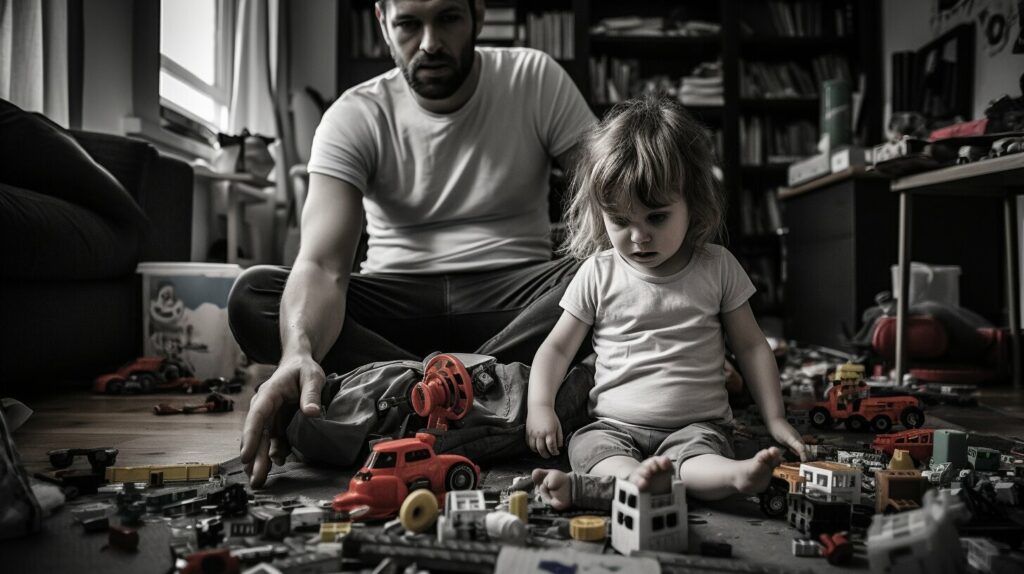Welcome to our guide on how to explain emotions to a child. As a parent, you know that helping your child understand their emotions is crucial for their overall development. Emotional intelligence is a valuable skill that can benefit children throughout their lives, and it all starts with understanding and expressing emotions effectively.
In this guide, we’ll cover the importance of emotional education, creating a safe and supportive environment for your child, and techniques for identifying, expressing, managing, and regulating emotions. We’ll also provide tips for teaching empathy, perspective-taking, and problem-solving skills. By the end of this guide, you’ll have a better understanding of how to explain emotions to a child and help them develop healthy emotional intelligence.
Key Takeaways
- Emotional intelligence is crucial for children’s overall development.
- Creating a safe and supportive environment is essential for children to express their emotions.
- Teaching children to identify, express, manage, and regulate emotions is key to developing emotional intelligence.
- Encouraging empathy, perspective-taking, and problem-solving skills are also crucial for children’s emotional development.
The Importance of Emotional Education for Children
As a parent, it’s essential to understand the significance of emotional education when it comes to your child’s development. Emotional intelligence is a crucial aspect of a child’s growth and well-being, as it impacts their ability to communicate effectively, handle conflict, and form healthy relationships with others.
Teaching children about emotions helps them recognize, express, and regulate their feelings, which leads to better emotional management and problem-solving skills.
Research has shown that children who receive emotional education are more likely to have higher self-esteem, better academic achievement, and fewer behavioral problems.

By introducing your child to emotional education, you’re providing them with a strong foundation for their social and emotional development. It’s never too early to start helping your child understand their emotions and how to express them in healthy ways.
Creating a Safe and Supportive Environment
When attempting to help children understand and express their emotions, it’s crucial to create a safe and supportive environment. Let your child know that it’s okay to feel emotions and that they can talk to you about anything without fear of judgment or punishment. Encourage open communication by actively listening to your child and validating their feelings.
Empathy is an essential aspect of understanding emotions. It’s important to show empathy when your child expresses their emotions and to help them understand that you understand how they’re feeling. Phrases such as “I understand that you’re feeling frustrated right now” can go a long way in helping them feel validated.
Teach your child to be empathetic towards others as well. Encourage them to think about how their actions and words might affect other people and to consider things from someone else’s perspective. This will help them build stronger relationships and develop a deeper understanding of emotions.
Creating a safe and supportive environment also means establishing boundaries. Let your child know what is and isn’t acceptable behavior when expressing their emotions. Teach them healthy ways to cope with big emotions, such as taking deep breaths, going for a walk, or talking to a trusted adult. Establishing these boundaries will help your child feel empowered in managing their emotions.
 Image source: https://seowriting.ai/32_6.png
Image source: https://seowriting.ai/32_6.pngIdentifying and Labeling Emotions
One of the key steps in guiding your child’s emotional growth is helping them identify and label their emotions. By being able to recognize and name their feelings, children can gain greater control over their emotional responses and develop their emotional intelligence.
Start by talking to your child about different emotions and what they mean. Use examples from everyday life and ask your child how they would feel in certain situations. This can help them connect their own experiences with specific emotions.
When your child is expressing a strong emotion, whether positive or negative, help them label it. For example, if they’re excited about a playdate, you might say, “It sounds like you’re feeling really happy and looking forward to your friend coming over.
Similarly, if they’re upset about something, help them identify the root emotion. For example, if they’re throwing a tantrum over a toy, you could say, “I can see that you’re feeling frustrated because you really wanted to play with that toy.”
By helping your child label their emotions, you’re teaching them to recognize and acknowledge their feelings in a healthy way. This can help them communicate more effectively and build their emotional self-awareness.

Encouraging Emotional Expression
Encouraging your child to express their emotions is an important part of their emotional development. By understanding and talking about their feelings, children can learn to manage them in a healthy way. Here are some techniques you can try:
- Journaling: Provide your child with a notebook or diary where they can write down their thoughts and feelings. This can help them process their emotions and identify patterns in their behavior.
- Art: Encourage your child to express their emotions through art. Drawing, painting, and coloring are all great ways for children to visually represent their feelings.
- Physical activity: Exercise and physical activity can help children release emotions in a healthy way. Encourage your child to engage in activities that they enjoy, like dancing or playing sports.
Remember to provide a non-judgmental and supportive environment for your child to express their emotions. Let them know that it’s okay to feel different emotions, and that you are there to listen and help them manage their feelings.

Teaching Empathy and Perspective-Taking
Teaching empathy and perspective-taking can greatly benefit your child’s emotional intelligence. It helps them understand their own emotions better while also being able to recognize and empathize with the emotions of others.
Here are some ways you can teach empathy and perspective-taking:
- Encourage your child to listen actively when someone is speaking to them. This helps them understand the other person’s perspective.
- Play “what if” games with your child. For example, you can ask them how they would feel in a particular situation or how they think others might feel.
- Read books that feature characters with different backgrounds and experiences, and discuss with your child how they might feel in the character’s situation.
- Teach your child to recognize nonverbal cues, such as body language and tone of voice. This helps them understand how others are feeling.
By teaching empathy and perspective-taking, you’re helping your child develop important emotional skills that will benefit them throughout their life.

Managing and Regulating Emotions
A key aspect of emotional intelligence is the ability to manage and regulate your emotions. It’s an important life skill that can significantly impact your child’s overall well-being. Teaching your child healthy ways to deal with overwhelming feelings can help them develop emotional resilience and cope better with life’s challenges.
One helpful technique for managing emotions is deep breathing. Encourage your child to take slow, deep breaths when they feel overwhelmed. You can teach them a simple breathing exercise: Ask them to inhale deeply through their nose, hold their breath for a few seconds, and then exhale slowly through their mouth. This can help calm their nervous system and reduce feelings of anxiety or stress.

Another effective technique is teaching your child to identify their emotions and express them in healthy ways. For example, if your child is feeling angry, encourage them to express themselves through words instead of physical actions. You can also model this behavior by showing them how you express your own emotions in a healthy manner.
Teaching your child healthy coping strategies is also essential. Help them develop a toolbox of techniques they can use when they’re feeling overwhelmed. This could include distraction techniques like listening to music or engaging in a favorite hobby, or mindfulness exercises like meditation or yoga.
Finally, it’s important to teach your child that it’s okay to ask for help when they need it. Encourage them to talk to a trusted adult or seek support from a mental health professional if they’re struggling to manage their emotions on their own.
Practicing Emotional Problem-Solving
Helping your child learn how to problem-solve when dealing with emotions is an essential skill for their emotional development. By teaching your child problem-solving strategies, they will learn to navigate challenging emotional situations, build resilience, and develop a sense of control over their emotions.
One effective method for problem-solving is to encourage your child to break down the problem into smaller, more manageable parts. Help them identify the specific emotions they are feeling and the trigger that caused the emotion. Then, work together to brainstorm possible solutions to the problem. Encourage your child to evaluate each solution and choose the one that is most likely to achieve a positive outcome.
Another technique for emotional problem-solving is to help your child reframe their negative thoughts into positive ones. For example, if your child is feeling anxious about a test, help them reframe their negative thought of “I’ll never pass this test” into a positive thought of “I’ve studied hard and I have the skills to do well on this test.”
It’s also important to teach your child the importance of taking a break when emotions become overwhelming. Encourage them to take deep breaths or engage in a calming activity, such as drawing or listening to music, to help them regulate their emotions. Encourage them to return to problem-solving once they feel more centered.
Remember, practicing emotional problem-solving with your child takes time and patience. Be supportive and encourage your child as they learn to navigate their emotions. By helping your child develop their problem-solving skills, you are providing them with a valuable tool to manage their emotions in a healthy way.

Modeling Emotional Intelligence
To help your child develop emotional intelligence, it is important to model healthy emotional expression and regulation yourself. Children learn by watching the behavior of the adults around them, so it is crucial to be mindful of how you handle emotions in front of your child.
When you are feeling upset, try to stay calm and use positive coping strategies such as taking deep breaths, going for a walk, or talking to a trusted friend or family member. This will show your child that it is possible to manage emotions in a healthy way.
Additionally, try to use language that reflects emotional awareness. Use feeling words when you talk about your own emotions and encourage your child to do the same. For example, you might say, “I’m feeling frustrated right now because I can’t find my keys. Have you ever felt frustrated like that?”
By modeling emotional intelligence for your child, you are providing them with a valuable example to follow. It takes practice and effort, but with consistency and patience, you can help your child develop strong emotional intelligence skills that will benefit them throughout their life.

Conclusion
As a parent, helping your child understand and express their emotions is an important aspect of their overall development. By fostering emotional intelligence, you can equip your child with the tools necessary for effective communication and healthy relationships.
Remember to create a safe and supportive environment for open communication, and to help your child recognize and label their emotions. Encourage emotional expression through various activities and techniques, and teach empathy and perspective-taking as crucial skills for understanding emotions.
Additionally, it’s essential to help your child manage and regulate their emotions, and to teach them problem-solving skills in relation to emotions. Finally, model emotional intelligence for your child by showcasing healthy emotional expression and regulation in your own life.
By following these tips and strategies, you can help your child develop a strong emotional foundation that will benefit them throughout their lives.
Can I Use the Same Strategies to Explain Depression and Other Emotions to My Child?
Explaining depression and other emotions to a child requires different strategies. When discussing how to explain depression to a child, it’s important to use age-appropriate language and concepts they can grasp. Focusing on feelings, such as sadness or loss of interest, can help them understand. However, when discussing other emotions like happiness or anger, it’s beneficial to emphasize triggers and appropriate expressions. Tailoring your approach can assist your child in comprehending and managing their emotions effectively.
How Can I Explain Hell to Kids in a Friendly and Compassionate Way?
When discussing a challenging topic like explaining hell to kids with compassion, it’s essential to approach it in a sensitive manner. Keep in mind that children have tender hearts and vivid imaginations. Use age-appropriate language and metaphors to help them understand difficult concepts. Emphasize the importance of love, kindness, and forgiveness, counterbalancing the notion of hell with the idea of personal choices and consequences. Ultimately, assure them that they are cherished and safe, fostering an environment of understanding and empathy.
FAQ
Q: How do I explain emotions to my child?
A: Explaining emotions to your child can be done through open communication and age-appropriate language. Use examples, stories, and visuals to help them understand different emotions and their meanings.
Q: Why is emotional education important for children?
A: Emotional education is crucial for children as it helps them develop emotional intelligence, empathy, and better communication skills. It also promotes mental well-being and helps children navigate their emotions effectively.
Q: How can I create a safe and supportive environment for my child to express their emotions?
A: Create a safe and supportive environment by actively listening to your child, validating their feelings, and showing empathy. Establish open lines of communication and encourage them to express their emotions without judgment.
Q: How can I help my child identify and label their emotions?
A: Help your child identify and label their emotions by using age-appropriate language and providing examples. Ask them how they feel and validate their emotions. Teach them emotional vocabulary to expand their understanding.
Q: How can I encourage my child to express their emotions in healthy ways?
A: Encourage your child to express their emotions by providing them with various outlets such as drawing, journaling, or talking. Teach them coping strategies and model healthy emotional expression yourself.
Q: How can I teach my child empathy and perspective-taking?
A: Teach empathy and perspective-taking by exposing your child to different perspectives and discussing feelings and reactions. Encourage them to put themselves in others’ shoes and consider different viewpoints.
Q: How can I help my child manage and regulate their emotions?
A: Help your child manage and regulate their emotions by teaching them calming techniques such as deep breathing or counting. Provide them with strategies for self-soothing and teach them the importance of self-care.
Q: How can I teach my child emotional problem-solving?
A: Teach your child emotional problem-solving by discussing various scenarios and helping them brainstorm solutions. Encourage them to think critically, consider others’ feelings, and find positive ways to handle emotional challenges.
Q: How can I model emotional intelligence for my child?
A: Model emotional intelligence by expressing your own emotions in a healthy way, talking about your feelings, and demonstrating empathy towards others. Show your child that it is okay to feel and express emotions.






